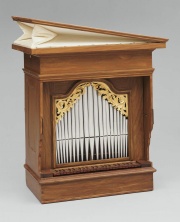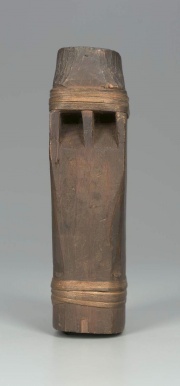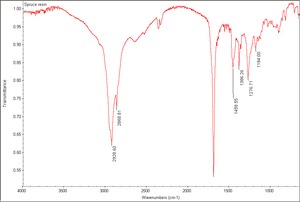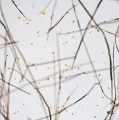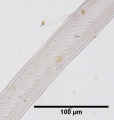Difference between revisions of "Spruce"
| Line 1: | Line 1: | ||
| − | [[File:17.1939-SC14445.jpg|thumb| | + | [[File:17.1939-SC14445.jpg|thumb|German organ<br>MFA #: 17.1939]] |
== Description == | == Description == | ||
| − | Any of several trees from the ''Picea'' family native to North America. Spruce trees, in general, have light weight, soft wood with a straight, even grain. The strong wood is easily worked. It is used for musical instrument sounding boards, ladders, cabinets, boxes, [[paper%20pulp|paper pulp]], and [[rayon%20fiber|rayon]] | + | Any of several trees from the ''Picea'' family native to North America. Spruce trees, in general, have light weight, soft wood with a straight, even grain. The strong wood is easily worked. It is used for musical instrument sounding boards, ladders, cabinets, boxes, [[paper%20pulp|paper pulp]], and [[rayon%20fiber|rayon]]. |
[[File:17.2206-SC29680.jpg|thumb|'''MFA Acc. #:''' 17.2206]] | [[File:17.2206-SC29680.jpg|thumb|'''MFA Acc. #:''' 17.2206]] | ||
| Line 9: | Line 9: | ||
Eastern spruce; épicea (Fr.); Schwartztanne (Deut.); picea (Esp.); espruce (Port.); black spruce (''Picea mariana''); blue spruce (''Picea pungens''); Engelmann spruce (''Picea engelmannii''); red spruce (''Picea rubens''); Sitka spruce (''Picea sitchensi''); white spruce (''Picea glauca'') | Eastern spruce; épicea (Fr.); Schwartztanne (Deut.); picea (Esp.); espruce (Port.); black spruce (''Picea mariana''); blue spruce (''Picea pungens''); Engelmann spruce (''Picea engelmannii''); red spruce (''Picea rubens''); Sitka spruce (''Picea sitchensi''); white spruce (''Picea glauca'') | ||
| + | == Physical and Chemical Properties == | ||
{| class="wikitable" | {| class="wikitable" | ||
|- | |- | ||
| Line 14: | Line 15: | ||
| 23-44 ppcf | | 23-44 ppcf | ||
|} | |} | ||
| − | |||
Paper fiber type: Softwood. Using transmitted light microscopy, fibers are identified by the presence of very small, oval, piceoid ray parenchyma pits, 2-4 across. May show cupressiod or taxodiod features. Ray tracheids are non-dentate. Appearance with [[Graff "C" stain]]: varies with pulping method . Average dimensions of fibers: length, 3.4mm width 3.1 μm. Common pulping method: [[kraft process|kraft]] and [[sulfite process|sulfite]]. It is difficult to distinguish spruce fibers from [[hemlock]] fibers in pulp. | Paper fiber type: Softwood. Using transmitted light microscopy, fibers are identified by the presence of very small, oval, piceoid ray parenchyma pits, 2-4 across. May show cupressiod or taxodiod features. Ray tracheids are non-dentate. Appearance with [[Graff "C" stain]]: varies with pulping method . Average dimensions of fibers: length, 3.4mm width 3.1 μm. Common pulping method: [[kraft process|kraft]] and [[sulfite process|sulfite]]. It is difficult to distinguish spruce fibers from [[hemlock]] fibers in pulp. | ||
Revision as of 13:53, 12 October 2020
Description
Any of several trees from the Picea family native to North America. Spruce trees, in general, have light weight, soft wood with a straight, even grain. The strong wood is easily worked. It is used for musical instrument sounding boards, ladders, cabinets, boxes, Paper pulp, and rayon.
Synonyms and Related Terms
Eastern spruce; épicea (Fr.); Schwartztanne (Deut.); picea (Esp.); espruce (Port.); black spruce (Picea mariana); blue spruce (Picea pungens); Engelmann spruce (Picea engelmannii); red spruce (Picea rubens); Sitka spruce (Picea sitchensi); white spruce (Picea glauca)
Physical and Chemical Properties
| Density | 23-44 ppcf |
|---|
Paper fiber type: Softwood. Using transmitted light microscopy, fibers are identified by the presence of very small, oval, piceoid ray parenchyma pits, 2-4 across. May show cupressiod or taxodiod features. Ray tracheids are non-dentate. Appearance with Graff "C" stain: varies with pulping method . Average dimensions of fibers: length, 3.4mm width 3.1 μm. Common pulping method: kraft and sulfite. It is difficult to distinguish spruce fibers from Hemlock fibers in pulp.
Additional Information
Schoch, W., Heller, I., Schweingruber, F.H., Kienast, F., 2004:Wood anatomy of central European Species: Common Spruce,Norway Spruce, Picea abies Karsten
Additional Images
Sources Checked for Data in Record
- G.S.Brady, Materials Handbook, McGraw-Hill Book Co., New York, 1971 Comment: p. 758
- F. H. Titmuss, Commercial Timbers of the World, The Technical Press Ltd., London, 1965 Comment: Picea glauca density = 23-33 ppcf
- Dictionary of Building Preservation, Ward Bucher, ed., John Wiley & Sons, Inc., New York City, 1996
- External source or communication Comment: Northern Pine Manufacturers: air-dry weight = 27pcf
- Marja-Sisko Ilvessalo-Pfäffli. Fiber Atlas: Identification of Papermaking Fibers (Springer Series in Wood Science). Springer, 1995.
- Walter Rantanen. "Fiber ID Course." Integrated Paper Services. June 2013. Lecture.
- Edward Reich, Carlton J. Siegler, Consumer Goods: How to Know and Use Them, American Book Company, New York City, 1937
- CRC Handbook of Chemistry and Physics, Robert Weast (ed.), CRC Press, Boca Raton, Florida, v. 61, 1980 Comment: density=30-44 ppcf (0.48-0.70 g/cm3)
